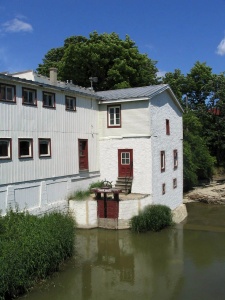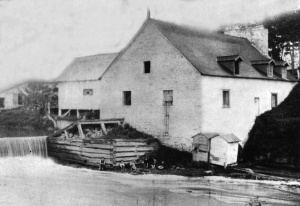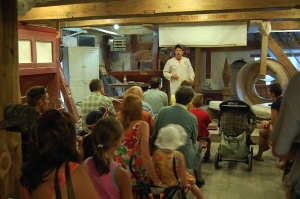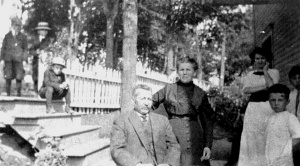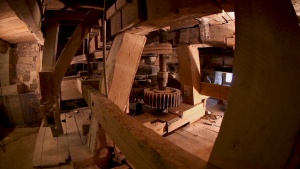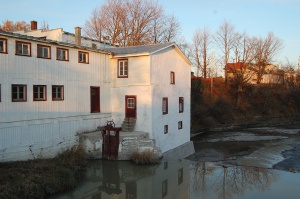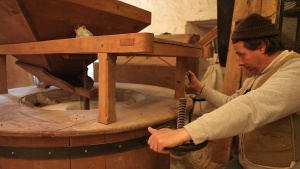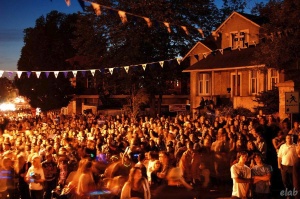The Légaré Mill in Saint Eustache, Quebec
par Marcotte, Léopoldine
Ever since its construction in 1762, the Légaré Mill has operated on water power alone. From the beginning the flour mill played a vital role in the development of Saint Eustache, quickly becoming the focal point for the first commercial establishments and village centre that grew up around it. Today, it is the oldest continually-operating facility of its kind in Canada, still operated by a miller using time-honoured techniques and the original equipment, integral and inseparable parts of a single process. As a venue for local festivities and events and home to all manner of cultural and recreational activities year-round, the Légaré Mill has been part of life in Saint Eustache for some 250 years—living on as an invaluable living testament of the tangible heritage and traditional know-how of the early French Canadians.
Article disponible en français : Moulin Légaré de Saint-Eustache au Québec
An Undisputed Heritage Landmark
Few water-driven flour mills have survived the waves of modernization and industrialization that swept over North America in the latter half of the 19th century. The Légaré Mill was the first flour mill built in the Mille-Îles seigneurie. While it has not always been the biggest or most productive, it is the only one to have weathered the myriad socioeconomic changes that came over time.
This grist mill is built on several levels, each dedicated to a different step in the flour-making process. Each bears the stamp of both the epoch of its construction and the modifications made to it over time. The original mill looked very much like a private residence with a gabled roof, dormers and a large chimney on its façade. These architectural features reflect the standard building techniques used for the first mills built in Canada.
Since 1978 Corporation du moulin Légaré has maintained a year-round interpretation centre at the mill. There visitors discover the workings of the traditional machinery and the artisanal milling techniques used to make wheat and buckwheat flour with the original millstones. While flour is still milled strictly by traditional methods, the latest technologies are enlisted to publicize the mill’s rich heritage. The mill has become known as a place where “history meets the present day.” Over 20,000 visitors come to get a taste of that history every year, often taking buckwheat or wheat flour home with them. Historians and other experts were first to champion the heritage value of the mill, which was officially recognized by Quebec’s culture ministry in 1967 and named a national historic site by the government of Canada in 2000.
No Ordinary Flour Mill
The mill was built as part of the basic infrastructure of the Mille-Îles seigneurie on the banks of the Chêne River, future location of Saint Eustache. Building a flour mill for his censitaires or tenants was among the seigneur’s duties under the seigneurial system; in exchange tenants were bound to do all their milling at the seigneur’s mill. The miller was responsible for collecting a milling tax, a part of which went to the seigneur. The tax was known in French as the banalité, making Légaré Mill a moulin banal—in French this carries the double-meaning of an “ordinary” mill. First established in the days of New France, the seigneurial system remained in force in Lower Canada after the British conquest of 1760, and was officially abolished in 1854.
History of a Seigneurie
The area’s first seigneur, Michel Sidrac du Gué de Boisbriand, died in 1688 without fulfilling his duty to populate his territory. When his heirs also failed to honour the terms of the concession, the land reverted to king of France in 1714. In 1739 the seigneurie was granted to the Lambert-Dumont family. Eustache-Louis Lambert-Dumont was the first seigneur to truly contribute to local development.
The mill was built in 1762. In the years that followed, it spurred local economic activity and played a pivotal role in the development of what would become Saint Eustache, remaining the property of the seigneurs and the descendants of the Lambert-Dumot family for just over a century. In 1865 it passed into the hands of Charles-Auguste-Maximilien Globensky (1830-1906), who in 1854 had married Virginie-Marguerite Lambert-Dumont (1839-1874), heiress of one of the first seigneurs.
In 1891 Globensky hired a miller, Magloire Légaré, who took ownership of the mill in 1907. Thus began a 75 year family saga that would see various members of the Légaré family take the helm. Magloire remained owner until his death in 1924. His widow, Virginie Villiotte dit Latour, inherited all Magloire’s worldly possessions. She oversaw mill operations for many years, one of very few women to run a business in early 20th century Quebec. In 1953 Latour sold the mill to her son Donat, whose younger son Philippe helped keep the family business running smoothly. In 1978 Donat handed over the mill to the city of Saint Eustache. He died two years later at age 80. Philippe kept working at the mill and living in the attached house with his sister Lucille until 1995. The miller’s house was eventually converted into office space for the Corporation du moulin Légaré.
250 Years of Changes
While the mill’s inner workings remained unchanged over the years, its outward appearance was fundamentally altered several times. Around 1880 the original waterwheel was replaced by the Leffel turbines still in use today. Although more powerful than the waterwheel, the turbines required much less space. As a result, not only was the interior of the mill refurbished, but all the original machinery designed for use with a waterwheel was modified as well. The next major addition was the miller’s house in 1902. Since then little has changed.
The Corporation du moulin Légaré was created in 1976 to preserve the oldest operating flour mill in Canada. Its main goal was to protect and promote the mill itself while keeping the miller’s craft alive. Over 35 years later the Corporation still boasts a dedicated team focused on protecting this exceptional heritage landmark, backed by hundreds of volunteers who make the mill’s wide-ranging cultural and recreational activities possible. With time the Corporation’s role has reached beyond the Légaré Mill to include stewardship of a number of Old Saint Eustache heritage buildings.
Since 2007 major restoration work has been done to brace shifting masonry walls. Proper restoration of the walls and the various levels is crucial to preserving the building and preserving the machinery that enables the mill to continue producing flour by traditional methods. Such restoration work is only to be expected after 250 years of active service.
Preserving and Passing On Traditional Know-How
The Corporation du Moulin Légaré is dedicated to preserving and passing on traditional know-how; naturally, this includes the miller’s traditional craft, an invaluable intangible heritage. There is no training program in Quebec to learn this traditional trade. Knowledge is acquired through hands-on learning of skills and techniques passed down from generation to generation, an apprenticeship that takes four to five years to complete. Légaré miller Daniel Saint-Pierre has been plying his trade for close to 25 years. He learned from Philippe Légaré, with whom he worked for eight years before taking over the mill. Daniel Saint-Pierre has also begun training an apprentice, a former guide who gradually succumbed to the charms of the miller’s way of life and has been learning the ropes to ensure that this trade lives on.
Since traditional craft techniques are generally passed on from one living person to another, it is crucial that the knowledge skilled artisans possess be preserved for future generations. To this end, the Corporation did more than simply restore the facilities: it also undertook to document the miller’s craft. The project was carried out in collaboration with the Canada Research Chair in Heritage at Université Laval. Interviews were conducted with the miller and his apprentice and multimedia records made of various daily tasks—valuable tools for reconstituting the memory of the site and the knowledge that brings it to life.
A Unique Heritage
At 250 years and counting, the Légaré Mill is North America’s oldest continually operating flour mill still running on water power alone. Residents of Saint Eustache have long acknowledged its importance. Originally servicing the community’s basic needs, the mill is now a symbol of its heritage and identity. Maintaining the mill as a focal point for residents, tradespeople, and tourists is crucial. Today, it remains an important gathering place for Saint Eustache residents.
The miller’s craft is central to the singular experience enjoyed by mill visitors, customers and other artisans who come to share in his knowledge. Recording the miller’s know-how makes it possible to preserve and above all share key information about this intangible heritage that played such a central role in our culture. This endeavour, long desired by the Corporation, will fuel future heritage projects. Restoring the mill and documenting and disseminating traditional milling knowledge will help keep the heritage of the Légaré Mill alive and well.
Léopoldine
Marcotte
Heritage Project Manager, Corporation du moulin Légaré
Bibliography
Bélisle, Jean, Journal de la Société pour l’étude de l’architecture au Canada, « Le moulin Légaré, Saint-Eustache (Québec) », pp.49-62, Volume 28, numéros 1, 2, 2003.
Revue Histoire Québec, Moulins du Québec, janvier 97, vol.2, no.2 [en ligne] http://www.histoirequebec.qc.ca/publicat/v2n2_som.htm
Additional DocumentsSome documents require an additional plugin to be consulted
Images
-
 Animation au moulin L
Animation au moulin L
égaré avec guid... -
 Arts-en-Fête, juin 20
Arts-en-Fête, juin 20
08 -
 Au moulin Légaré, dét
Au moulin Légaré, dét
ail des stries ... -
 Daniel et Martin, meu
Daniel et Martin, meu
nier et apprent...
-
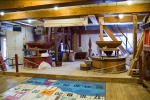 L'intérieur du moulin
L'intérieur du moulin
Légaré -
 La chute du grain de
La chute du grain de
blé dans la meu... -
 La chute du sarrasin
La chute du sarrasin
dans la meule -
 La famille Légaré au
La famille Légaré au
début du XXe si...
-
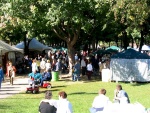 Le festival de la gal
Le festival de la gal
ette et des sav... -
 Le meunier du moulin
Le meunier du moulin
Légaré, ajustan... -
 Le moulin en hiver
Le moulin en hiver
-
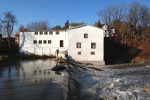 Le moulin Légaré
Le moulin Légaré
-
 Le moulin Légaré
Le moulin Légaré
-
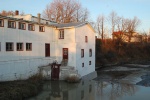 Le moulin Légaré aprè
Le moulin Légaré aprè
s la restaurati... -
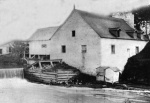 Le moulin Légaré avan
Le moulin Légaré avan
t 1902 -
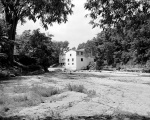 Le moulin Légaré dans
Le moulin Légaré dans
les années 195...
-
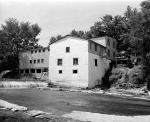 Le moulin Légaré, pre
Le moulin Légaré, pre
mier moulin à f... -
 Le moulin vers 1920
Le moulin vers 1920
-
 Le site du moulin Lég
Le site du moulin Lég
aré à Saint-Eus... -
 Les engrenages du mou
Les engrenages du mou
lin Légaré
-
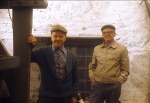 Les frères Donat et P
Les frères Donat et P
hilippe Légaré... -
 Tournage au moulin av
Tournage au moulin av
ec l’équipe de ... -
 Travaux de restaurati
Travaux de restaurati
on du mur sud e...
Hyperliens
- Moulin Légaré et Vieux-Saint-Eustache
- La Corporation du moulin Légaré
- Moulin Légaré dans le Répertoire des biens culturels du Québec
- Légaré Mill National Historic Site of Canada

